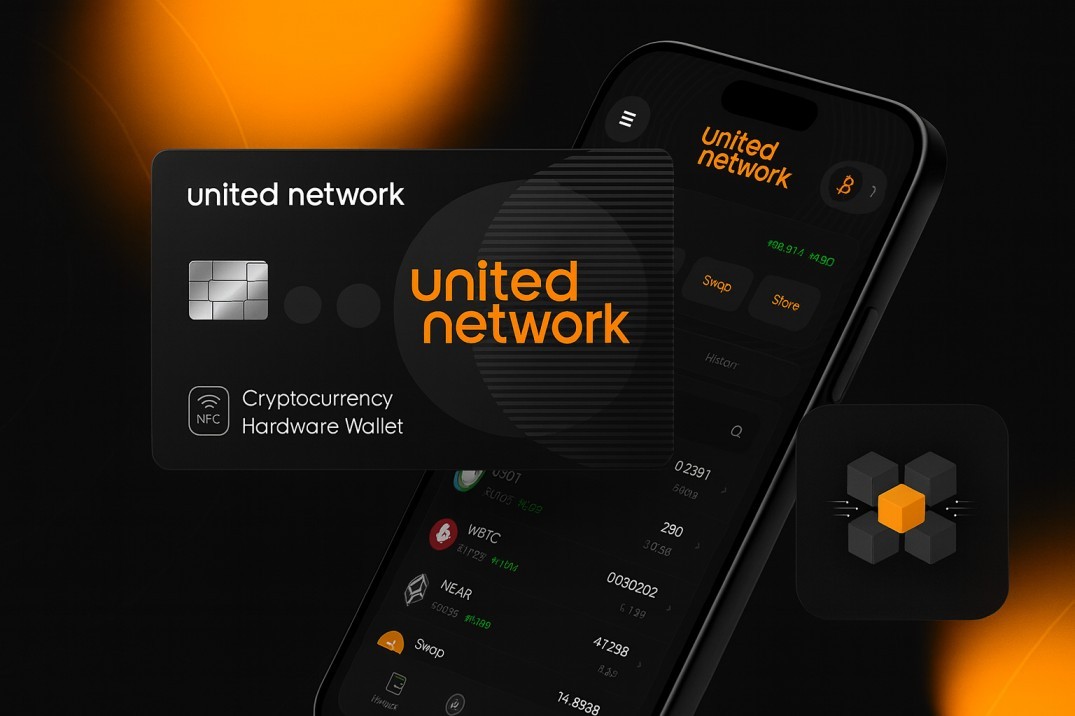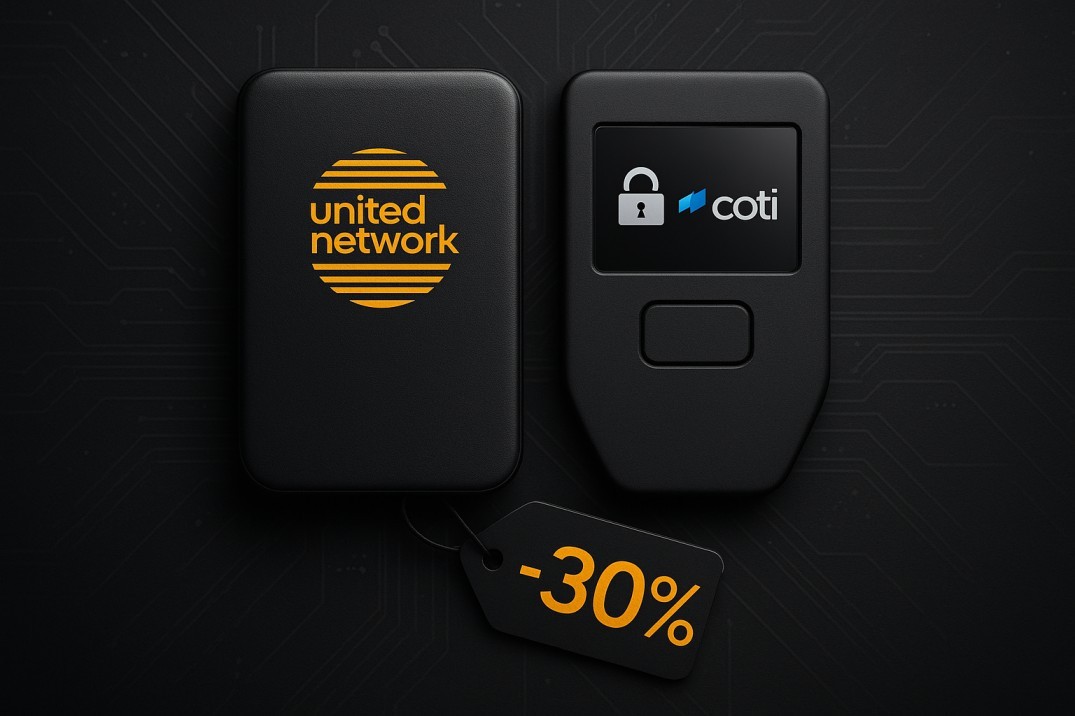TL;DR
- COTI has partnered with United Network (UN) Wallet, whose NFC card wallet merges cold storage security with tap-to-pay convenience in a non-custodial format.
- The UN Wallet card signs all transactions on-chip, so private keys never leave the card, and communication uses FIDO-level security.
- Through this partnership, UN will integrate COTI's privacy tech (garbled circuits) into its wallet, enabling confidential transactions on the COTI network.
- This move lowers the barrier for non-custodial crypto use in everyday life, making self-custody as simple as tapping a card.
- For COTI, this means more real-world adoption, improved UX for privacy users, and a hardware channel to extend its ecosystem.
In the world of payments, one thing people expect is simplicity. Swipe your card, tap, and it goes through. Yet in crypto, most self-custody solutions remain clunky: seed phrases, hardware dongles, Bluetooth, USB cables, complex user flows. For many, that complexity remains a barrier to adoption.
That's why COTI's partnership with United Network (UN) Wallet is so promising. It places self-custody crypto into a familiar form factor - a card you tap. But under that simplicity sits strong security: the card holds private keys, signs transactions offline, and your smartphone only acts as a broadcaster.
As crypto grows beyond niche users, everyday usability becomes vital. The ability to tap your card and send crypto privately could be a turning point in adoption. Let's explore how the UN Wallet operates, what this partnership brings to COTI, and what it signals for the future of privacy & payments.
What Is UN Wallet (United Network NFC Card Wallet)

United Network presents an NFC card wallet that functions as a secure, non-custodial hardware wallet, but with everyday convenience. According to their website, it allows users to send, receive, swap, and store crypto - while private keys remain offline on the card itself.
The main idea: combine cold storage security (keys never leave the device) with tap-to-pay convenience. Transactions are signed directly by the card's secure chip, then broadcast via the paired smartphone. This architecture brings together the benefits of multi-chain access, NFC convenience, and self-custody control.
According to a UN wallet website, UN Wallet supports major blockchains (Bitcoin, Ethereum, Solana, Arbitrum, Avalanche, Polygon, BNB, TON, Tron, and others) - with more networks expected in the future.
The card is battery-free, wireless, and designed in a standard card format, meaning it fits in a wallet like a regular card. Thus, UN Wallet aims to make self-custody as intuitive as using a contactless debit or credit card. Co-founder of United Network, Danylo Rumiantsev puts,
How the UN Wallet Works: Security + Workflow
To appreciate what this partnership brings, it helps to walk through how the UN Wallet functions behind the scenes.
Transaction & Signing Flow
1. Tap the card to your phone's NFC chip.
The smartphone app pairs with the card via NFC. Depending on phone model, tapping locations may vary (top, center).
2. Enter your PIN.
After tapping, you enter a PIN on your phone. The card's secure chip uses this PIN to unlock signing capabilities.
3. Transaction creation and broadcast.
The app or interface builds the transaction (destination, amount, gas, etc.) and sends that unsigned transaction to the card. The card signs it internally, then returns the signed transaction to the phone, which broadcasts it to the network.
4. Keys never leave the card.
Your private keys are generated and stored within the secure chip. They are never exposed, transmitted, or accessible to external interfaces. This is the core of its security model.
Security Architecture & Chip Standards
The card uses a certified secure chip that supports FIDO authentication standards, which are widely recognized as robust in security and identity.
The communication between the card and the smartphone is protected by FIDO-level security protocols, ensuring the commands going back and forth cannot be intercepted or manipulated. Because the signing logic is done on-chip, it removes many attack vectors (i.e. malware on phone, network intercepts) that plague software wallets.
Multi-Chain & Web3 Access
One of the strengths of UN Wallet is its support of many blockchains. From the user side, the card can interface with apps or browser extensions to access Web3 dApps. The card acts like a secure key signer behind the scenes.
In essence, the card becomes your "wallet identity," usable across multiple ecosystems - but always anchored in local, offline security.
What the Partnership Means for COTI
Native Support + Privacy Integration
By partnering with UN Wallet, COTI plans to embed native support for all COTI L2 transactions and COTI tokens in the card wallet. That means users can tap to transact on COTI's network using the same secure card.
More importantly, United intends to integrate COTI's privacy solution (garbled circuits) into the wallet's firmware or logic. This integration would let transactions signed via the card enjoy confidential execution on COTI's private stack.
Thus, a user tapping the card to pay could also trigger a private contract execution or private token transfer - combining convenience, privacy, and security in one flow.
Driving Real-World Adoption
This hardware channel opens a bridge between COTI's privacy infrastructure and mass-market users. Many users want security and simplicity; few want to wrestle with seed phrases or hardware dongles. The card abstracts those complexities. Also, for skeptics who associate crypto with complexity or risk, a card interface feels familiar. That lowers the cognitive barrier for adoption.
With COTI-supported UN Wallets in the wild, more users might move native activity onto COTI, increasing network effect, usage, and liquidity in its ecosystem.
Branding, Roadmap & Future Wallets
As described in their announcement, the partnership anticipates COTI-themed hardware wallets in the future - with personalized branding and interface elements. These cards might come with additional features specific to COTI's network.
In parallel, UN plans to expand its wallet's swap providers (liquidity integrations) to support more efficient in-wallet token exchanges. Over time, the aim is to support gasless transactions, real-world assets, and on-chain identity - all areas of strong interest to COTI. So the card wallet becomes not just storage and transaction hardware, but a user interface to COTI's entire ecosystem.
How to Buy & Use the UN Wallet with COTI

Below is a simplified step-by-step for users wanting to get onboarded with the card + COTI integration. (Note: always refer to official guides for exact sequences.)
Purchasing
- Go to United Network's store to purchase the NFC crypto wallet card.
- Use the promo code COTI30 to get a 30% discount off the list price.
Setup & Initialization
- Tap your card to your phone.
Initiate pairing via NFC. - Write down your seed phrase.
The seed phrase is a backup; store it securely (offline). - Set a PIN.
This protects your card from unauthorized use. - Connect to the UN Wallet app or interface.
You'll see your multi-chain wallet dashboard (balances, assets, etc.).
At this point, the wallet is ready to transact.
User Feedback & Early Impressions
From initial users and early reviews from the website:
- Mark, July 20, 2025: "Next gen wallet."
- NimB0x, July 17, 2025: "I have been using this wallet card for a few weeks ... extremely convenient ... security features give me peace of mind ... design is user-friendly. Highly recommend."
- Alexxx, July 19, 2025: "Best wallet I've tried !!"
These early quotes reflect what the collaboration aims to deliver: strong security, ease of use, and everyday convenience.
Challenges & Considerations
While this partnership is promising, a few challenges merit attention:
- Firmware & privacy integration complexity
Embedding garbled circuit logic into card firmware is nontrivial and may require optimized, minimal circuits. - Chip resource constraints
The secure chip on the card has limited CPU, memory, and power (since it is passive). Privacy logic must be frugal. - Ecosystem compatibility
The card must integrate smoothly with wallets, dApps, bridges, and COTI's privacy stack - maintaining seamless UX. - Security audits & hardware risk
The card must be audited thoroughly (chip, firmware, NFC communication) to prevent side-channel attacks. - Adoption and trust curve
Users may be cautious adopting new hardware solutions; strong transparency, support, and documentation will matter.
Yet, these are the kinds of engineering challenges that thoughtful teams can overcome over time. The upside is large.
Conclusion
The partnership between COTI and United Network's NFC card wallet may seem like a simple hardware integration, but its implications are deep. It marries the world of cold, private infrastructure with the UX expectations of everyday payments.
For users, it promises an intuitive, secure, non-custodial way to tap and transact in crypto - no clunky seed phrases in every transaction. For COTI, it provides a vector for real-world adoption, privacy integration into consumer hardware, and deeper ecosystem anchoring.
Tap-to-pay crypto is no longer a sci-fi vision. With this card, and with COTI privacy under the hood, the dream of private, convenient, everyday crypto may finally come to life.











